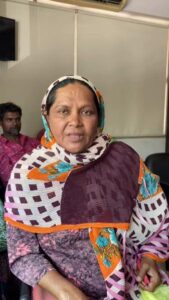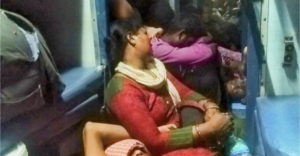The earliest images depicting stories of Shiva’s marriage and conflicts with demons such as Andhaka and Ravana were carved about 1,500 years ago at the Jogeshwari caves in North Mumbai and on the Elephanta island off South Mumbai. All this indicates that around the 6th century CE, the Pashupata cult thrived in this region. It was probably patronised by the Kalachuri dynasty, who controlled the northern Konkan region (Aparanta), and were rivals of the southern Chalukyas.
Mumbai has a long history with tribal, Buddhist, Jain, Hindu, Muslim and Christian roots, dating from Mauryan times. To appreciate this, we need to appreciate a bit of geography. There are three parts to the city.
- The Ulhas River of North Mumbai
- The Salsette island in the middle
- The Seven Islands of South Mumbai
The gods of the north Mumbai is an island separated from the mainland by a river called Ulhas that connects to the Arabian sea at two ends. On the western end is Vasai creek and on the eastern end is Thane creek.
North of this river are the suburbs of Vasai, Virar and Nalasopara, which was the ancient port town of Sopara mentioned in the Jatakas and the Mahabharata. Also mentioned in ancient texts is Kalyan, located in the interior — in Thane, connected to the western and eastern creeks.
This spot marked the beginning of the Aparanta region, linked north to Lata region (Gujarat) and south to Konkan region (Maharashtra). Nearby is Ghorbander, or Ghode-bandar, a port from which horses (ghoda) came to this region from faraway Persia and Arabia.
Buddha visited too
As per Buddhist legends, a grand vihara (monastery) was built by a Buddhist merchant named Purna Maitrayaniputra. Buddha himself paid a visit to this shrine, suggesting its existence 2,500 years ago. Then, 2,300 years ago, Ashoka built a stupa here where he told his subjects that respecting fellow humans earns more merit than religious rituals conducted at time of birth, marriage and death.
The region came under control of Satavahana kings who controlled the Godavari basin and were often in conflict with Kshatrapas of Gujarat, who sought control over the western coast. These kings built Buddhist caves for traders who had to cross the Sahayadri mountains to reach the ports.
These caves — some with stupas, some with images of Buddha — have largely been encroached or simply forgotten. A few have been converted to goddess shrines like the Jivadani Mata temple in Virar, related to the local Ekavira devi, after whom Virar gets its name.
As per Hindu legends, this is where Parashurama came after killing the wicked Kshatriyas of Arya-desha and first reclaimed land. Later, Shankaracharya, and his followers, visited this spot (like Buddha of yore) legitimising it as a pilgrim spot (tirtha-kshetra).
Around the 10th century, Shilahara kings built temples in this region such as Chakreshwar temple at Nalasopara and Ambarnath temple near Ulhasnagar. These temples are in ruins and it is not clear if the temples were destroyed by Portuguese or were neglected due to loss of patronage or if locals hid the statues of the gods to prevent vandalism.
Among the statues found and placed in a newly built Shiva Chakreshwar temple, at Nalasopara, are images of goddesses, Surya riding seven horses, Mahishasura-mardini, four-armed Vishnu and a magnificent image of a three-headed and four-armed Brahma (or Vishwakarma).
Jains, who typically settle in trading zones, argue that the name Chakreshwar comes from a Jain yakshi called Chakreshwari who carries the image of Rishabha-deva on her head. Hindus confuse Rishabha-deva with Shiva as both have matted hair and are represented by a bul.
A nod to wandering holy men
Vasai (Bassein) was taken over by the Sultans of Gujarat in the 14th century. While being controlled by Muslims, this region saw the arrival of many sufis and ghazis such as Haji Malang, whose dargah still stands in the Thane-Kalyan area atop a steep hill, now a popular trekking site. Below on the plateau are sites linked to Haji Malang’s disciples, the Panch-Pir, legendary holy men who travelled on magic carpets to India from Mecca.
Many Hindus claim that this site is linked to the wandering Nath-jogis, such as Matsyendranath, who visited the Vasai-Virar regions to bathe in its numerous sulphur-water hot springs linked to yoginis such as Vajreshwaridevi.
This region was claimed in the 16th century by the Portuguese. The oldest churches built by the Portuguese are found in Vasai. During their conflict with Marathas, many churches were ransacked. And according to researchers, over 30 church bells were moved to Hindu temples such as those in Nashik (Rameshwar), Kolhapur (Mahalakshmi), Jejuri (Khandoba) and Osmanabad (Tulja Bhavani) across Maharashtra.
The Salsette island
The main island of Mumbai, south of Ulhas river, was called Salsette by the Portuguese after the 66 (saha-sashti in the local language) villages that it once housed. On this giant island stands Gilbert Hill, an old volcanic rock squeezed out of the earth 60mn years ago. At nearby Kandivali, Stone Age implements have been found indicating it is an old habitation.
Here lived the original inhabitants of the land — Koli (fisherfolk), Kunbi (farmers), Agri (salt makers), Bhandari (toddy tappers) — long before kings brought in the educated Brahmins and Prabhu (scribes) to administer the wealth flowing into the land from its ports.
These people established the local gods and goddesses: Gam-devi (who marks villages), Jair-Mari-Sithala (who cures disease), Wagh-dev (who protects from tigers) and Nag-dev (who protects from snakes).
The intermingling of faiths
The traders who came to this island carved over a 100 Buddhist caves in and around this area, the most prominent being Kanheri caves (Borivali) and Mahakali caves (Andheri). Around 1,500 years ago, with the Kalachuri kings, Hindu gods began appearing in this region, replacing Buddhist shrines. The Jogeshwari caves had images of Shiva and his yoginis, of which only one, Jogeshwari, became prominent.
Shilahara kings controlled this region about between 9th and 12th century, as indicated by a thousand-year-old hero-stone showing a naval battle found in Borivali and now housed in Aquaria Grande building society, near Eksar village.
Bandra, or Bandara (port), marks the southern tip of Salsette island. On a hill overlooking the sea was the shrine of Mot Mauli (pearl mother), mother of fisherfolk, found in the sea, like a pearl. When the locals converted to Christianity, the temple became the Church of Mount (probably from Mot) Mary (probably from Mari-ai, or water mother) who holds Jesus Christ in her hand.
When the Marathas conquered Bassein in 1739 CE, the Portuguese destroyed this church and shifted the sacred image across the bay to Mahim Church. Even today people of all faiths attend mass for nine Wednesdays (novena), a practice similar to Hindu observances (vrata), seeking protection and prosperity.
Locals who were converted to Christianity by Portuguese came to be known as Portuguese Christians while those who were converted by the British East India Companies came to be known as East Indian Christians.
The shrines of South Mumbai
In 1661 CE, seven islands of bom-bahia (which means good bay in Portuguese) south of Salsette islands, were given as part of royal dowry by the Portuguese to the British monarch Charles II. They built the Sion fort to mark the boundary between Parel island, controlled by the British, and Salsette island controlled by the Portuguese. Bombay island was known to the locals as Mumbai after a local village goddess known as Mumba-devi.
Greeks sailors referred to Mumbai as Heptanesia (seven islands) about 1,800 years ago. In Parel island, an 11-feet-tall and rather unusual Shiva image has been found with six Shiva forms emanating from the central one. It was probably built by the Kalachuris who carved Shiva images in Elephanta and Jogeshwari about 1,500 years ago.
A thousand years ago, the islands were controlled by Shilahara kings who established the Bangganga temple complex. As per local lore, this tank was established by Ram who shot an arrow (bana) into the ground to release water to quench Sita’s thirst. This was a Vaishnav shrine, the first in the region dotted by temples dedicated to Shiva and various yoginis and gramadevis.
The Pathare Prabhu community came to these islands via Kalyan-Kalwa Thane, along with their king, Bhimba-dev, and their goddess, Prabha-devi, in the 13th century, escaping the onslaught of the Khiljis who swept across Gujarat and the Deccan, destroying the Yadava stronghold of Devagiri (near Ellora). As per a Marathi text called Bimbakhyan, they established themselves in Mahikavati, which is now known as Mahim. He built a temple for Shiva in a garden of Babool trees that came to be known as Babulnath. This temple was forgotten but was rebuilt in the 18th century.
When the Sultans of Gujarat took over this region (14th to 16th century), many Sufis and Ghazis visited these islands. These were Central Asians, Arabs and Persians who were addressed as Haji as they had performed the Hajj pilgrimage and so were revered.
Their tombs became pilgrim sites. The famous ones are in Mahim (Makhdoom Ali Mahimi Shafi’i given the title of Qutb-e-Konkan, or Pole Star of Konkan) and at Worli (Haji Ali).
The arrival of the Parsis
When the British arrived on the scene, Surat was the major port of the Western regions and a major source of revenue for the Mughals. In 1664 CE, Surat was sacked by Chatrapati Shivaji. This incident, in the long run, helped both the British and the city of Mumbai, as artisans and traders began moving to the seven islands for safety, protected by the British. This included the migration of the Parsi community from coastal Gujarat.
They worked with the British, participated in the opium and cotton trade, and played a key role in the rise of the city and its many institutions. This is why Mumbai is dotted with many Parsi fire temples. The earliest Parsi temple was built in 1701 near the British Fort George.
About 200 years ago, between 1770 CE and 1850 CE, the British reclaimed the sea, joined the seven islands and connected them with the Salsette island by building Sion and Mahim causeways. The Prabhu community played a key role in the reclamation of the islands.
To prevent water from Worli creek from flooding the city, a wall had to be built along the sea. But it kept collapsing until a local from the Pathare Prabhu community dreamt of images of the three goddesses lost at sea. These were found and housed in the now famous Mahalakshmi temple on a hill, overlooking Haji Ali dargah.
Worshipped with lotus flowers, people often forget that the image of the lion before the three images is to remind us that the triple goddess is a form of Adi Shakti, who is a warrior-goddess, killer of demons, and not simply the goddess of fortune.
In 1801, the Siddhi Vinayak temple was built by a local contractor and a childless woman in the hope of wish fulfilment. The image is similar to the one found in Banganga, and suggests it may have been carved originally by an artisan who lived 800 years ago, before it was rediscovered and enshrined near Prabhadevi.
Today Mumbai remains a bustling commercial city — a cosmopolis eternally under construction, with roads, highways, expressways, vast slums, massive gated communities, high rises, airports, flyovers, and ports. But the many goddesses who form its foundations have not been forgotten thanks to neighbourhood names like Kalbadevi, Jogeshwari, Mahakali, Gamdevi, Golfa Devi, Mahalakshmi, Shitaladevi and Prabhadevi.
(Devdutt Pattanaik writes on relevance of mythology in modern times, especially in areas of management, governance and leadership. He defines mythology as cultural truths revealed through stories, symbols and rituals. Courtesy: The author’s website, https://devdutt.com.)




